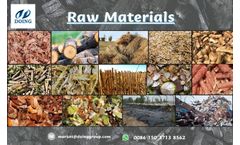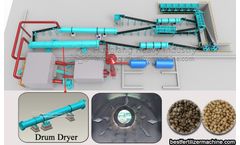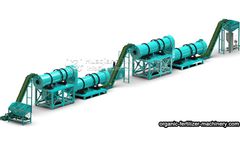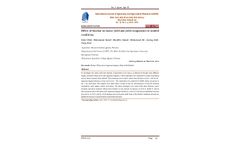Refine by
Sugarcane Articles & Analysis: Older
42 articles found
Common types of agricultural waste suitable for charcoal production include: Agricultural waste ● Crop Residues: Rice straw, corn stalks, wheat straw, and sugarcane bagasse. ● Wood Chips and Sawdust: From pruning, logging, and woodworking operations. ● Nutshells: Coconut shells, almond shells, and walnut shells. ...
Waste from crops like rice, corn, and sugarcane can be converted into biochar, turning what would otherwise be waste into an asset. ...
Biodegradable Materials The adoption of biodegradable materials such as sugarcane bagasse or bamboo fiber offers a sustainable alternative to traditional pulp sources. ...
From beet juice to classic rock salt to urea, we now have plenty of choices when it comes to eliminating ice from roadways. However, most snow removal pros are still looking for a silver bullet: A material that will de-ice roads in any condition, for a reasonable price, without harming the environment. ...
Those who work the land here do so in relative isolation; they grow rice and sugarcane as best they can, in a patchwork of green and brown pastures sweeping over India’s Eastern Ghats. “We used to use a dhenki[1] to harvest rice from our fields,” explains one of the women in Keragam, where villagers have long relied on manual labour to irrigate their paddies ...
Sustainability starts at the source—and Amyris’ feedstock source is sustainably harvested sugarcane, certified by Bonsucro, a global non-profit organization founded by the World Wildlife Fund that ensures responsible sugarcane production, processing, and trade. ...
Agriculture, feed and fertilizer industries, such as straw, grass, leaves, fish meal, corn paste, starch residue, distiller's grains, medicine residue, fruit residue, soy sauce residue, sugarcane bagasse, peat, organic compound fertilizer, sludge, aquatic product waste, food factory waste, slaughterhouse waste, fertilizer production line, phosphate fertilizer ammonium sulfate. 3. ...
With the high cost and shortage of modern agricultural labor, the application of sulfur coated urea in some crops also shows its characteristics. For example, planting sugarcane, because the growth period of sugarcane is several months, it is not easy to carry out mechanized fertilization after sugarcane crown is closed. At the early stage of ...
After crops are harvested and processed, farmers could be left with plenty of waste to dump, including rice hulls, peanut shells, coconut shells, sugarcane bagasse, etc. In decades past, there seemed to be merely a limited variety of approaches to dump such agricultural waste. ...
With around 50-80 dry tonnes of biomass yield per hectare every year, Arundo donax (giant reed) is way ahead of its competitors. Of course, this yield depends on climate and applied agricultural technology. In this article below, the studies carried out concerning the biomass yield and economics of Arundo donax are presented. Biomass production in the Mediterranean: Italy, Spain and Sicily ...
EPA also has been granting emergency exemptions for sulfoxaflor since 2012, with the most recent emergency exemptions granted on June 17, 2019, for the use of sulfoxaflor to control tarnished plant bugs on cotton in 12 states, and to control sugarcane aphids on sorghum in 14 states. In the July 12, 2019, decision adding new uses, restoring previous uses, and removing certain ...
To investigate the maize yield and nutrient concentration in its leaves as affected by biochar from different organic materials (wheat straw and sugarcane bagasse), a field experiment was conducted on maize crop during 2013 at koont research farm chakwal. The treatments were control, wheat straw biochar at 5t ha-1, and 10t ha-1, sugarcane bagasse biochar at 5t ...
In this paper, we demonstrate in a clear procedure the application of the Anaerobic Digestion Model No. 1 (ADM1) to model a large-scale covered in-ground anaerobic reactor (Cigar), processing sugarcane vinasse from a biorefinery in Brazil. The biochemical make-up (carbohydrates, proteins, and lipids) of the substrate was analysed based on the food industry standards. Two ...
”Nik Cunniffe MLN usually arises from the interaction of two viruses: maize chlorotic mottle virus (MSMV) and sugarcane mosaic virus (SCMV). The researchers from France, Germany, United Kingdom and the United Sates modelled the dynamics of SCMV and MCMV infection within and between maize growing periods, either during the long- or short-rain growing seasons. ...
Vinasse has been used as fertilizer by sugarcane growers, due to its potential to completely replace mineral fertilizers. ...
This research was to study the efficiency of the Fenton's treatment process for the removal of three herbicides, namely 2,4-dichlorophenoxy acetic acid (2,4-D), ametryn and dicamba from the sugarcane field runoff water. The treatment process was designed with the Taguchi approach by varying the four factors such as H2O2/COD (1–3.5), H2O2/Fe2+ (5–50), pH (2–5) and reaction ...
Adsorption of arsenite (As(III)) from aqueous solutions onto iron oxide impregnated sugarcane bagasse was investigated in this study. The linear regression analysis showed that Langmuir adsorption isotherm fitted well to the experimental data. ...
Sugarcane is an important agricultural crop grown on the east coast of Australia. ...
So let us understand economics of sugarcane. One acer of land will give 40 tonnes of sugarcane for a good crop. 40 tonnes of sugarcane will give 25 tonnes of sugarcane juice i.e. 25000 kg = 1 lakh juice glasses of 250 ml. ...
In conjunction with Bonsucro, a sustainability standard setting body for the sugarcane sector, an indicator was developed to ensure that water consumed in sugarcane cultivation is used productively, i.e. that producers achieve high “crop per drop.” To be easily measurable, sugarcane water productivity was adapted so that yield could be compared ...














